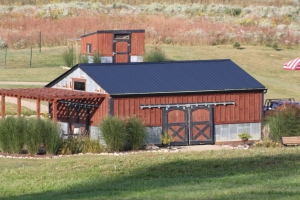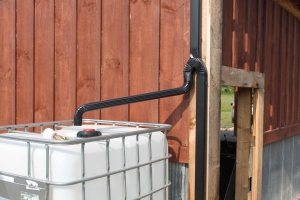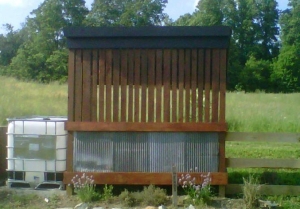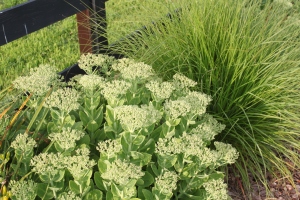When we first began to clear the land for our little farm in the fall of 2010 – one of our biggest concerns was water – or should I say, lack of water at the property.
Without a well or natural spring – we worried about how we would supply water to our future fruit trees, mini-vineyard and landscape plants – not to mention the hundreds of vegetable plants we planned on growing in the garden!
But as we head into the 2015 growing season nearly 5 years later, we have yet to dig a single well – and yet – those initial H20 worries are nothing more than a distant memory!
How so? Well (no pun intended), with the addition of few simple and inexpensive rain water collection systems set up around the farm – we now have more than enough water stored on site for all of our needs and more.
The best part of all, these methods can be easily adapted to almost any home to handle your outdoor watering needs as well, saving valuable natural resources from your well or city water supply – not to mention saving you the money it takes to use them!
It’s also a huge benefit to your plants considering that rain water won’t contain any of the trace chemicals that many find in their tap water.
Use and Adapt Existing Gutters…

Using the basic 32′ gutters from the barn – we can collect almost 250 gallons of rain water during a single rain
One of the easiest ways to begin collecting water is from existing gutters and downspouts. With the simple and inexpensive installation of a water diverter to your existing downspout, and the addition of a holding tank for storage – you can collect and store hundreds of gallons of rain water every time Mother Nature sends it down from the sky.
That is exactly what we did when we built our barn that very first year, and it quickly allowed us to collect and store the much-needed water for our newly planted trees and garden. (see: Building our Recycled Barn)
The barn itself is a standard rectangular structure measuring 32′ long x 26′ wide.
It has a standard gabled metal roof measuring 13′ wide x 32′ long on each side – with a 32′ section of guttering runs along the bottom of each side of the metal roof that to carries the rain water down to the side of the barn – much like that of any standard house or outbuilding.
From there, both sides empty into standard downspouts – and it’s there at those common downspouts where our water-collecting magic starts.
About 5′ off of the ground, we installed a simple 2-way in-line diverter to the downspout (see picture to the right). When the metal lever is slid to the left, the rain water is diverted from the normal downspout into a 275 gallon storage tank that we located on the side of our barn. And with every rain, the tank fills with precious water. So much in fact, that in a single two-hour downpour – we can collect as much as 125 gallons or more!
When the tank is full, the switch can be slid back for normal drainage.
Don’t Forget Outbuildings…
If for some reason your house or barn are unable to work as your collection source – don’t forget about using those small outbuildings you might have on your property.
The very same process can be used on small structures such as sheds, chicken coops, garages and more – and don’t think for a minute that because the buildings are small, that they won’t collect a large amount of rainwater.
We installed an 8′ section of gutter on the back of our tiny corn crib – and fed the downspout into an additional tank up by the garden. From that tiny 8′ x 3′ wide roof – we collected a full 275 gallons of water over the course of a few hard spring rains – and it allowed us to water our entire garden all summer.
What to Collect The Water In..
As for what to collect your water in – although there are commercial (and expensive) rain storage tanks and barrels on the market – you can utilize recycled plastic 55 gallon drums or large plastic totes to keep it on the cheap. We found our totes for $40 each after a quick search on Craigslist – and with each of them holding up to 275 gallons of water – we can store several weeks worth of watering in a full tote.

Recycled water totes are a great way to store and use rainwater – just make sure your totes are clean and were not used to hold harsh chemicals that could leave harmful residues.
In addition to Craigslist or local selling walls, you can also check with local food plants that may receive their raw materials in them.
One word of caution – no matter what you use, make sure you know what was originally in your tanks or barrels and that it is safe. Our tanks were used to hold maple syrup and molasses – simple food products that can be cleaned out and re-used. You will want to avoid using tanks that held harsh chemicals, or are of unknown origin. Most tanks come with a 6″ threaded cap on top, and a 2″ threaded outlet valve at the bottom. You can convert the bottom 2″ valve to accept a standard garden hose with a few adapters found at your local hardware store.
Keep It Dark and Keep It Covered:
You will want to keep the water from getting direct sunlight to keep algae from growing in the stagnant water. Algae can only grow if there is light. If your tank is translucent like ours, you will want to cover it. We use a black tarp to cover them up once the sun and algae become a problem. Not only does it dress it up, but it keeps the water and the flow line crystal clear.
You will also want to keep your storage tanks closed. Water that sits is an open invitation to mosquito larvae . Our totes came with 6″ caps and lids on the top. We simply cut out the hole for the downspout, and then sealed the edge with some inexpensive foam.
Know What To Use The Water For:
Be safe with what you use your water for. We use our reclaimed water for watering trees, landscape and garden plants – and for washing off equipment, etc. Since we do not treat it in any way, we do not use it for drinking.
Last – check to make sure your allowed to collect rain water in your state. Although it sounds crazy (and is!), in some states out west you are not allowed to collect rain water, as the water rights still belong to the state. So to be on the safe side, check with your local or state government to make sure it’s legal where you live.
Happy Water Collecting! Jim and Mary
If you would like to receive our DIY & Gardening Tips every Tuesday – be sure to sign up to follow the blog via email in the right hand column, “like” us on Facebook, or follow us on Twitter.






